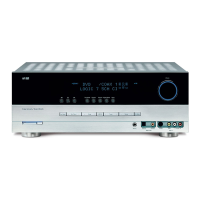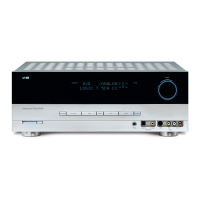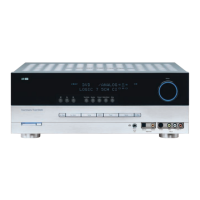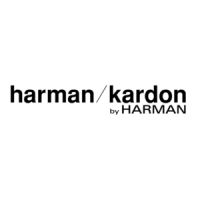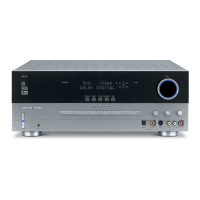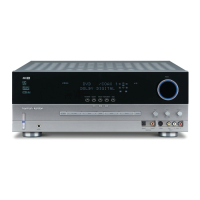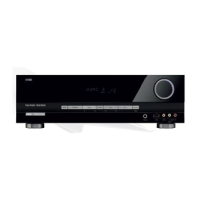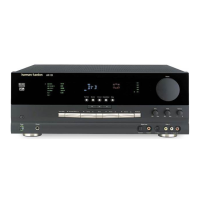SYSTEM CONFIGURATIONSYSTEM CONFIGURATION
SYSTEM CONFIGURATION 19SYSTEM CONFIGURATION 19
encoded in the source signal, depending on the con-
figuration of your system (e.g., 5.1 or 7.1) and the
number of channels encoded in the signal. Keep in
m
ind that the Dolby Digital EX and Dolby Pro Logic IIx
m
odes are available only when the AVR is set for
6.1/7.1 operation.
When Dolby Pro Logic II Music or Dolby Pro Logic IIx
M
usic is selected as the listening mode, three special
settings are available to tailor the sound field to your
listening room environment and your individual taste
and preferences. (When other Dolby Surround modes,
such as Dolby Pro Logic II Movie, are selected,
dashed lines will indicate that these settings are
not active.)
•
Center Width: This setting adjusts the balance
of the vocal information in the front soundstage
between the center and front left/right speakers.
The lower settings spread the center channel sound
more broadly into the left and right channels. A
higher number (up to “7”) produces a tighter center
channel presentation.
•
Dimension: This setting alters the perceived depth
of the surround field by creating a shallower presen-
tation that appears to move sounds toward the front
of the room, or a deeper presentation that appears
to move the center of the sound field toward the
back of the room. The setting of “0” is a neutral
default, with the range of adjustment shown as
“R-3” for a deeper, rear-oriented sound to “F-3”
for a shallower, front-oriented sound.
•
Panorama: Switching this setting on adds an
enveloping wraparound presentation, which
increases the perception of sound along the
sides of the room.
To change these parameters, press the
¤ Button
n while the DOLBY SURROUND submenu
is on the screen until the
› cursor is pointing to the
line on the menu with the parameter you wish to
change. Then, press the
‹/› Buttons o to alter
the setting to your taste.
When a Dolby Digital source is playing and the
DOLBY DIGITAL mode is selected, the
Night mode
settings may be available, if the program
material is encoded for Night mode, as shown in
Figure 6.
Figure 6
The Night mode is a feature of Dolby Digital that uses
special processing to preserve the dynamic range and
full intelligibility of a movie soundtrack while reducing
t
he peak level. This prevents abruptly loud transitions
f
rom disturbing others, without reducing the sonic
impact of a digital source. The Night mode is only
available when specially encoded Dolby Digital signals
are played.
To adjust the Night mode setting, make certain that the
› cursor is on the NIGHT line of the DOLBY
SURROUND
submenu. Next, press the ‹/›
Buttons o to choose between the following set-
tings, as they appear in the on-screen display:
OFF: When OFF is highlighted, the Night mode
will not function.
MID: When MID is highlighted, a mild compres-
sion will be applied.
MAX: When MAX is highlighted, a more severe
compression algorithm will be applied.
We recommend that you select the
MID setting as
a starting point and change to the
MAX setting later,
if desired.
The Night mode may also be adjusted directly any
time a compatible Dolby Digital source is playing by
pressing the
Night Mode Button l. When the but-
ton is pressed,
D-RANGE OFF will appear in
the lower third of the video screen and in the
Lower
Display Line
ı. Press the ¤ Button n within
3 seconds to select the desired setting.
The last option line in this menu is the setting to turn
the unit’s upsampling feature on or off. In normal use,
this feature is turned off, which means that digital
sources are processed at their native sample rate. For
example, a 48kHz digital source will be processed at
48kHz. However, the AVR 140 allows you to upsam-
ple the incoming 48kHz signals to 96kHz for added
resolution.
T
o take advantage of this feature,
press the
¤
Button n so that the › cursor is next to the
UPSAMPLING line and press the ‹/›
Buttons o until ON appears
.
Note that this feature
is only available for the Dolby Pro Logic II-Music,
Dolby
Pro Logic
II-Movie
, Dolby Pro Logic and
Dolby 3 Stereo modes.
When all settings for surround mode setup have been
made, press the
¤ Button n so that the ›
cursor is next to BACK TO SURROUND
SELECT
, and press the Set Button p to
return to the
SURROUND SELECT submenu.
On the
DTS menu, the choices made with the
‹
/
›
Buttons o on the remote are determined by a
combination of the type of program material in use
and whether the 5.1- or 6.1/7.1-channel configura-
tion is in use.
When a DTS source is playing, the choice of modes
will vary according to the type of program source
(DTS Stereo, DTS 5.1, DTS 96/24, DTS-ES Matrix or
D
TS-ES Discrete). Press the
‹
/
›
B
uttons
o t
o
s
croll through the choices that are available for your
system and the program in use.
W
ith no source playing, or while an analog audio
source is playing, you will only be able to view the
DTS Neo:6 surround mode choices. These include
DTS Neo:6 3-channel Cinema mode (recommended
when front left, right and center speakers are present
b
ut no surround speakers are available), DTS Neo:6
5-channel Cinema mode (recommended for movies
or television), DTS Neo:6 5-channel Music mode
(optimized for music-only materials), and DTS Neo:6
6-channel Cinema and Music modes (available when
the Surround Back speaker channels are configured
as either
LARGE or SMALL; see page 21).
When the 5.1 configuration is in use, the AVR will
automatically select the 5.1 version of DTS processing
when a DTS data stream is selected.
When the 6.1/7.1 mode is selected, the DTS-ES
Discrete mode will automatically be activated when
a DTS source with the ES Discrete “flag” is in use.
When a non-ES DTS disc is in use, you may select
the DTS-ES Matrix mode through this menu to create
a full eight-channel
surround mode.
When a DTS 96/24 signal is detected,
the AVR 140
defaults to the DTS surround mode, but reproduces
the higher-resolution materials that are present due to
the higher sampling rate automatically. See page 28
for a complete explanation of the DTS modes.
When the incoming bitstream is a DTS
digital signal,
the
A
VR 140’
s sophisticated microprocessor allows
you to select a “combination” mode that applies post-
processing so that Dolby Pro Logic IIx or DTS Neo:6
may be used to create back surround channels from a
2.0 or 5.1 source. This will appear in the
MODE line
by showing both the digital mode and the second
mode, separated by a plus sign (e.g.,
DTS+
DOLBY PRO LOGIC II MUSIC
).
On the
LOGIC 7
menu, the choices
made with
the
‹
/
›
Buttons o on the remote are deter
mined
by whether the 5.1- or 6.1/7.1-channel configuration
is in use.
In either case, the selection of a Logic 7
mode enables Harman Kardon’s exclusive Logic 7
processing to create fully enveloping,
multichannel
surround sound from either 2-channel Stereo or
Matrix-encoded programming such as VHS cassettes,
laser discs or television broadcasts produced with
Dolby
surround.
Y
ou may select the
Logic 7
/5.1 Music
,
Cinema or
Enhance mode, in the 5.1 configuration. Each works
best with 2-channel music recordings, surround-
* DOLBY SURROUND *
MODE:DOLBY DIGITAL
CENTER WIDTH:----
DIMENSION :----
PANORAMA :----
NIGHT :OFF
UPSAMPLING :----
BACK TO SURROUND SELECT
AVR 140 OM 3/29/06 3:45 PM Page 19
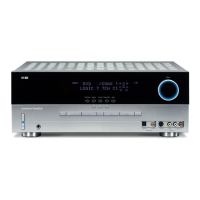
